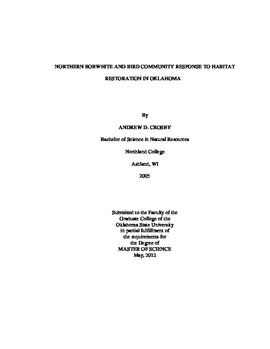| dc.contributor.advisor | Elmore, R. Dwayne | |
| dc.contributor.author | Crosby, Andrew D. | |
| dc.date.accessioned | 2014-04-15T21:59:40Z | |
| dc.date.available | 2014-04-15T21:59:40Z | |
| dc.date.issued | 2012-05-01 | |
| dc.identifier.uri | https://hdl.handle.net/11244/9165 | |
| dc.description.abstract | Reversing the population decline of Northern Bobwhites (Colinus virginianus, hereafter bobwhite), an economically important gamebird, in Oklahoma, is a priority for wildlife managers in the state. The Quail Habitat Restoration Initiative (QHRI) was initiated in 2008 to address this issue by doing cost-share with private landowners for the restoration of bobwhite habitat. The purpose of my study was to evaluate the effect of this program on bobwhites and other grassland bird species of conservation concern, and evaluate the key factors affecting the outcome of the program. There was very little bobwhite response to restoration treatments, and occupancy of restoration areas did not significantly increase. The main habitat factor effecting bobwhite occupancy on a sample unit was overstory canopy cover, with a secondary effect of visual obstruction. Bobwhite occupancy was also significantly affected by the amount of habitat within 1 km of the sample unit. Most restoration areas were within the appropriate landscape context for bobwhites to recolonize the site, but proper local habitat condition were only created within a few sample units and this was the limiting factor in the success of the QHRI program. Community analysis showed that bird community composition responded most strongly to overstory canopy cover and visual obstruction, and many declining grassland bird species were strongly associated with bobwhites in species groupings from cluster analysis. Bobwhites show the potential to act as an umbrella species for declining bird species that rely on early-successional habitat. Occupancy modeling showed that estimates of bobwhite occupancy may be biased low by as much as 30% if detection probability is not accounted for, especially in areas where they are uncommon. Maximizing detection probability in the study design, and accounting for it in the analysis, must be done if estimates of bobwhite occupancy are to be accurate. | |
| dc.format | application/pdf | |
| dc.language | en_US | |
| dc.publisher | Oklahoma State University | |
| dc.rights | Copyright is held by the author who has granted the Oklahoma State University Library the non-exclusive right to share this material in its institutional repository. Contact Digital Library Services at lib-dls@okstate.edu or 405-744-9161 for the permission policy on the use, reproduction or distribution of this material. | |
| dc.title | Northern Bobwhite and Bird Community Response to Habitat Restoration in Oklahoma | |
| dc.type | text | |
| dc.contributor.committeeMember | Leslie, David M., Jr. | |
| dc.contributor.committeeMember | Will, Rodney E. | |
| osu.filename | Crosby_okstate_0664M_11971.pdf | |
| osu.college | Agricultural Sciences and Natural Resources | |
| osu.accesstype | Open Access | |
| dc.description.department | Department of Natural Resource Ecology and Management | |
| dc.type.genre | Thesis | |
| dc.subject.keywords | habitat | |
| dc.subject.keywords | landscape | |
| dc.subject.keywords | northern bobwhite | |
| dc.subject.keywords | occupancy | |
| dc.subject.keywords | oklahoma | |
| dc.subject.keywords | restoration | |
